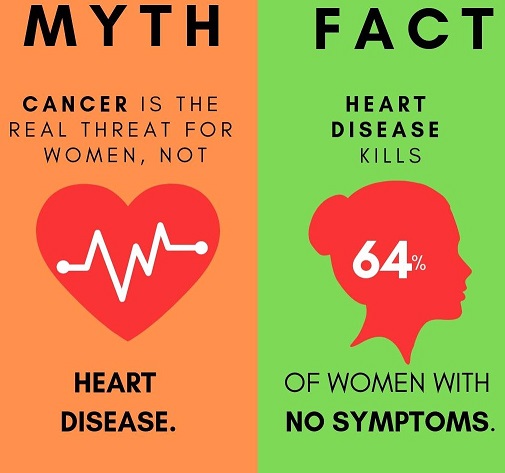Introduction:
In the realm of women’s health, myths and misconceptions often abound, perpetuated by outdated beliefs, cultural stereotypes, and misinformation. These myths not only contribute to confusion but also hinder women from making informed decisions about their health and well-being. By debunking these myths, we aim to empower women with accurate knowledge and promote proactive healthcare practices tailored to their unique needs.
Myth 1: Women don’t need to worry about heart disease as much as men.
Reality: Heart disease is the leading cause of death for both men and women worldwide. While it’s true that heart disease often manifests differently in women, with symptoms such as fatigue, shortness of breath, and nausea, it remains a significant health concern. Women should prioritize heart health through regular exercise, a balanced diet, and routine check-ups.

Myth 2: Breast cancer only affects older women.
Reality: While age is a risk factor for breast cancer, it can affect women of all ages, including younger women. Early detection through regular breast self-exams, clinical breast exams, and mammograms is crucial for detecting breast cancer at its earliest and most treatable stages.
Myth 3: Pregnancy protects against mental health issues.
Reality: Pregnancy and the postpartum period can be challenging times for women’s mental health, with conditions such as perinatal depression and anxiety affecting up to 1 in 5 women. The hormonal changes and emotional stressors associated with pregnancy and new motherhood can increase the risk of mental health issues. Seeking support and treatment is essential for maternal well-being.
Myth 4: Women lose bone density only after menopause.
Reality: While women do experience accelerated bone loss after menopause due to declining estrogen levels, bone density can also decrease before menopause, particularly during pregnancy and breastfeeding. Adequate calcium intake, weight-bearing exercises, and vitamin D supplementation are important for maintaining bone health at every stage of life.
Myth 5: Women don’t need as much sleep as men.
Reality: Both men and women require adequate sleep for optimal health and well-being. However, women are more likely to experience sleep disturbances due to hormonal fluctuations, pregnancy, and caregiving responsibilities. Prioritizing good sleep hygiene and seeking help for sleep disorders are crucial for women’s overall health.
Myth 6: Pap smears are only necessary if you’re sexually active.
Pap smears, which screen for cervical cancer, are recommended for all women aged 21 and older, regardless of sexual activity. Cervical cancer can develop due to human papillomavirus (HPV) infection, which can occur even in women who have never been sexually active.
Myth 7: Menstrual irregularities are always a cause for concern.
Reality: While irregular periods can sometimes indicate underlying health issues such as polycystic ovary syndrome (PCOS) or thyroid disorders, they can also be normal for some women, especially during adolescence and perimenopause. However, any significant changes in menstrual patterns should be evaluated by a healthcare provider.
Myth 8: Regular Checkups Are Only for Older Women
Reality: Regardless of age, women should have regular checkups with a gynecologist. These visits allow for early detection of potential problems, including sexually transmitted infections (STIs), cervical cancer, and hormonal imbalances.
Myth 9: Birth Control Causes Weight Gain
Reality: Weight gain associated with birth control is uncommon and often linked to lifestyle factors like diet and exercise. Different birth control options exist, and a doctor can help choose one with minimal side effects.
Myth 10: Skipping Periods is Healthy
Reality: Regular periods are a sign of hormonal balance. While occasional skipping might happen, consistently missing periods could indicate underlying health issues like PCOS or stress. Consulting a doctor is crucial.
Myth 11: Mammograms Are the Only Breast Health Check Needed
Reality: While mammograms are vital, they might not detect everything. Regular self-exams and discussing any lumps or changes with a doctor are equally important for comprehensive breast health.
Myth 12: Painful Periods Are Normal
Reality: Painful periods can be debilitating and shouldn’t be dismissed as “normal.” Underlying conditions like endometriosis or fibroids could be causing the pain. Consulting a doctor can lead to effective treatment options.
Myth 13: Cranberry Juice Cures UTIs
Reality: While cranberry juice might offer some preventative benefits, it cannot treat a full-blown UTI. Antibiotics prescribed by a doctor are necessary to clear the infection.
Myth 14: Wearing a Bra Increases Cancer Risk
Reality : There’s no scientific evidence linking bra use to breast cancer. Maintaining a healthy weight and regular screenings are key for cancer prevention.
Myth 15: Menopause Means the End of Sex Life
Reality: Menopause is a natural transition, not the end of sexual desire. Hormonal changes might affect libido, but there are solutions like lubricants and potentially hormone therapy, to discuss with a doctor, to maintain a fulfilling sex life.
Conclusion:
By dispelling these common myths about women’s health, we empower women to take control of their health journeys, armed with accurate information and resources. It’s essential to challenge misconceptions, advocate for inclusive healthcare practices, and prioritize preventive care to ensure that women of all ages lead healthy, vibrant lives.